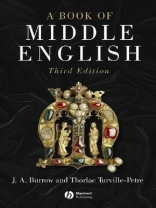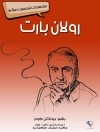This essential Middle English textbook, now in its third edition, introduces students to the wide range of literature written in England between 1150 and 1400.
* New, thoroughly revised edition of this essential Middle English textbook.
* Introduces the language of the time, giving guidance on pronunciation, spelling, grammar, metre, vocabulary and regional dialects.
* Now includes extracts from ‘Pearl’ and Chaucer’s ‘Troilus and Criseyde’.
* Bibliographic references have been updated throughout.
* Each text is accompanied by detailed notes.
Cuprins
List of illustrations.
Preface to the Third Edition.
Abbreviations.
Part One:.
1 Introducing Middle English.
1.1 The Period.
1.1.1 From Old to Middle English.
1.1.2 From Middle to Modern English.
1.2 Varieties of Middle English.
1.2.1 Regional Dialects.
1.2.2 Early and Late Middle English.
1.2.3 Spelling.
2 Pronouncing Middle English.
2.1 Introduction.
2.2 Vowels.
2.2.1 The Long Vowels.
2.2.2 The Short Vowels.
2.2.3 Unstressed Final -e.
2.2.4 The Diphthongs.
2.3 Consonants.
2.4 Stress.
3 Vocabulary.
3.1 Introduction.
3.2 Scandinavian.
3.3 English, French and Latin.
3.4 Latin Loan-Words.
3.5 French Loan-Words.
4 Inflexions.
4.1 Introduction.
4.1.1 The Inflexional System.
4.1.2 Loss of Inflexional Endings.
4.2 Nouns.
4.2.1 Introduction.
4.2.2 Noun Inflexions: Early Southern Texts.
4.2.3 Developments in Noun Inflexions.
4.2.4 Genitive Singular Without Ending.
4.2.5 Unchanged Plurals.
4.2.6 Mutated Plurals.
4.3 Pronouns and Articles.
4.3.1 Forms of the Personal Pronouns.
4.3.2 First and Second Person Pronouns.
4.3.3 Third Person Pronouns: Masculine and Neuter Singular.
4.3.4 Third Person Pronouns: Feminine Singular.
4.3.5 Third Person Pronouns: Plural.
4.3.6 The Definite Article.
4.3.7 Demonstratives.
4.3.8 The Indefinite Article.
4.4. Adjectives and Adverbs.
4.4.1 Definite and Indefinite Inflexions.
4.4.2 Inflexions for Case.
4.4.3 Comparison of Adjectives.
4.4.4 Comparison of Adverbs.
4.5 Verbs.
4.5.1 Introduction.
4.5.2 Present Tense.
4.5.3 Past Tense and Past Participle.
4.5.4 Past of Weak Verbs.
4.5.5 The Verbs ‘Have’ and ‘Say’.
4.5.6 Past of Strong Verbs.
4.5.7 Irregular Verbs.
4.5.8 The Verb ‘To Be’.
5 Syntax.
5.1 Gender.
5.2 Number.
5.3 Use of Cases.
5.3.1 Nominative and Accusative.
5.3.2 Genitive.
5.3.3 Dative.
5.4 Pronouns and Articles.
5.4.1 Dou and e.
5.4.2 Non-expression of Personal Pronouns.
5.4.3 Man.
5.4.4 Self.
5.4.5 Reflexive Pronouns.
5.4.6 Relative Pronouns.
5.4.7 The Articles.
5.5. Adjectives and Adverbs.
5.5.1 Position.
5.5.2 Comparatives and Superlatives.
5.5.3 Adjectives as Nouns.
5.6 Verbs.
5.6.1 Use of Present Tense.
5.6.2 Use of Past Tense.
5.6.3 Auxiliaries of the Past.
5.6.4 Auxiliaries of the Future: shall and will.
5.6.5 The Infinitive.
5.6.6 The Subjunctive.
5.6.7 The Imperative.
5.6.8 Impersonal Verbs.
5.6.9 Verbs of Motion.
5.6.10 The Passive.
5.7 Negation.
5.8 Questions.
5.9 Word-Order.
5.9.1 Inversion.
5.9.2 The Object.
5.9.3 Prepositions.
5.9.4 Relative Clauses.
5.9.5 Adverbial Phrases.
5.9.6 Verb in Final Position.
5.10 Recapitulation and Anticipation.
6 Metre.
6.1 Introduction.
6.2 Rhymed Verse.
6.3 Alliterative Verse.
6.4 Laamon’s Brut.
7 From Manuscript to Printed Text.
8 Select Bibliography.
8.1 Bibliographies and Indexes.
8.2 Language Studies.
8.3 General Studies of the Literature.
8.4 Studies of Particular Genres.
8.5 Historical and Social Studies.
Part Two: Prose and Verse Texts:.
Note on Treatment of Texts.
1 The Peterborough Chronicle 1137.
2 The Owl and the Nightingale.
3 Laamon: Brut.
4 Ancrene Wisse.
5 Sir Orfeo.
6 The Cloud of Unknowing.
7 William Langland: Piers Plowman.
8 Patience.
9 Sir Gawain and the Green Knight.
10 Pearl.
11 St Erkenwald.
12 John Trevisa: Dialogue between a Lord and a Clerk.
13 John Gower: Confessio Amantis.
14 Lyrics.
15 The York Play of the Crucifixion.
16 Geoffrey Chaucer: The Parliament of Fowls.
17 Geoffrey Chaucer: Troilus and Criseyde.
18 Geoffrey Chaucer: The Canterbury Tales.
Textual Notes.
Glossary
Despre autor
J. A. Burrow is Emeritus Professor at Bristol University. His many publications include Medieval Writers and their Work (1982) and Gestures and Looks in Medieval Narrative (2002).
Thorlac Turville-Petre is Professor of Medieval English Literature at the University of Nottingham. His previous publications include England the Nation (1996) and The Piers Plowman Electronic Archive, Vol. 2: Trinity College, Cambridge, MS B.15.19 (CD Rom, 2000).












